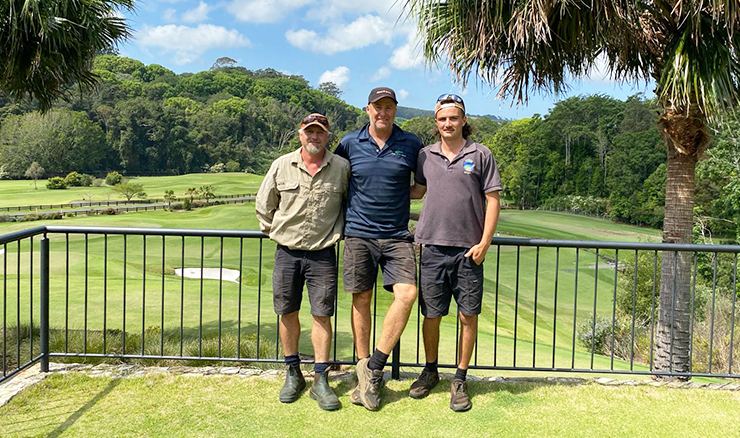10 Sep 2024 | Industry News |
#ThankASuper: Sustained quality at Teven Valley
by Martin Blake

For Paul Gumbleton, superintendent at Teven Valley golf course in the northern New South Wales hinterland near Ballina, his job is more correctly described as a labour of love.
Gumbleton grew up in golf, caddying for his father in Sydney and then playing. A stint of work experience on the superintendent’s staff at Bayview Golf Club in northern Sydney led to an apprenticeship at the same course at 16.
Gumbleton has subsequently worked on the greenkeeping staff at some of the nation’s top clubs – Kingston Heath in Melbourne, Monash Country Club and Pennant Hills in Sydney and Cromer Golf Club near Narrabeen – but for the past four years he has been at the forefront of a remarkable project in the northern New South Wales hinterland near Ballina.
Teven Galley golf course is a nine-hole gem on a gorgeous piece of land and in four short years has won plaudits throughout the industry, not only for the design of the Craig Parry golf course, but for its devotion to sustainability.
Golf NSW broke new ground by giving the course a leg of the NSW Open regional qualifying series last month, after which longtime touring pro Marcus Fraser said he was “completely speechless” at what had been done with the course.
Gumbleton and the club this year won the Claude Crockford Sustainability Award handed out by the Australian Sports Turf Managers Association, and Golf Australia magazine included the golf course in its top 100 public facilities, the only nine-holer to earn the accolade.
The project is the baby of Sydney banker Curt Zuber, who happened to be a Monash member at the same time that Gumbleton was head super at the northern beaches club.
Zuber asked Gumbleton – who has a love of construction to go with his passion for turf - to design and shape a golf hole in the garden at his Sydney home. Gumbleton built the hole, they became friends, and the rest is history.
When Zuber bought the 11-hectare property at Teven Valley in 2016 with the intention of building a golf course, he hired Gumbleton, who moved his family – wife Nikki and children Cooper, Harvey and Ellie – to northern NSW. Nikki took up the role as general manager of the new club, a job she recently stepped back from.
Gumbleton and his offsider Bob Simmons, another ex-Monash superintendent and 36-year assistant at Kingston Heath, shaped the land, installed the irrigation and drainage and created the course, which opened in 2021 as a public facility. It now has more than 400 members to show how successful they have been.
Sustainability was a key word throughout the project. The course is divided by the ecologically sensitive McGuires Creek which has platypus, turtles and fish thriving. Gumbleton and Simmons shaped the land as best they could at maximum three percent gradient “so that water would get away, rather than installing big drainage systems”.
They took out hundreds of non-indigenous trees and in consultation with Parry, chose to grow a new variant of grass for fairways called Sir Grange Zoysa, already popular in America but largely unheard of in Australia.
“It (Sir Grange) requires low inputs and that’s one reason why we selected it,” said Gumbleton. “We’re in a very unique environment, we have platypus. I didn’t want to be using grasses where I was required to constantly apply fungicide and insecticide.
“We were trying to build a sustainable golf course. Everything was around sustainability.
“Zoysa is probably the most expensive grass you can put down, but if I did a study, even in fuel saving because you’re not mowing as much, (saving with) your pesticides, fertiliser. If I did a case study, we’d already be in front.”
Gumbleton knows that it was a risk using a new grass, but he also now knows that it was the right call. “I haven’t fertilised the fairways there in some areas for four years,” he said.
Paul Gumbleton starts work at 5.30am most days with his team – assistant Garry Kunz and second-year apprentice James Bazzana. Quality is their byword. “It’s quality work looking back at the end of the day with some pride in what you do. Do it once, do it well, is the old saying,” observed Gumbleton.
Superintendents are often the butt of criticism from grumpy club members and – other than on days like this – rarely earn appropriate praise for good work. For Gumbleton, that is an occupation hazard.
“Look, it’s a really challenging job,” he said. “No two seasons are the same so you are evolving with the environment and the climate each season. I think superintendents give so much to their jobs because you’re working with something that’s living.
“There’s no stop time. You’re forever thinking about your greens whether you’re on holiday or you’re at home. It’s a 24-hour job being a superintendent, and that’s what it takes to produce high-quality playing surfaces. Superintendents need good teams around them, good committees and good support.
“I don’t think anyone starts greenkeeping for the money. It’s love of the outdoors, it’s love of working with the environment. I believe that’s where it starts for a lot of us.”
Join our newsletter
Get weekly updates on news, golf tips and access to partner promotions.
Related News
Asha Flynn awarded Karrie Webb Coaching Scholarship for 2025
Queensland's Asha Flynn has been awarded the second Karrie Webb Coaching Scholarship presented by Nippon Shaft.
Australian Golf Power Rankings: April 2
Two of Australian golf’s most feted young players delivered the goods when it mattered the most in a memorable week at home and abroad.
Aussies on Tour: Lee, Allan complete winning double
It was a long-awaited PGA TOUR breakthrough for Min Woo Lee and the end to a 23-year drought for Steve Allan in a magnificent weekend for Aussie golf.


